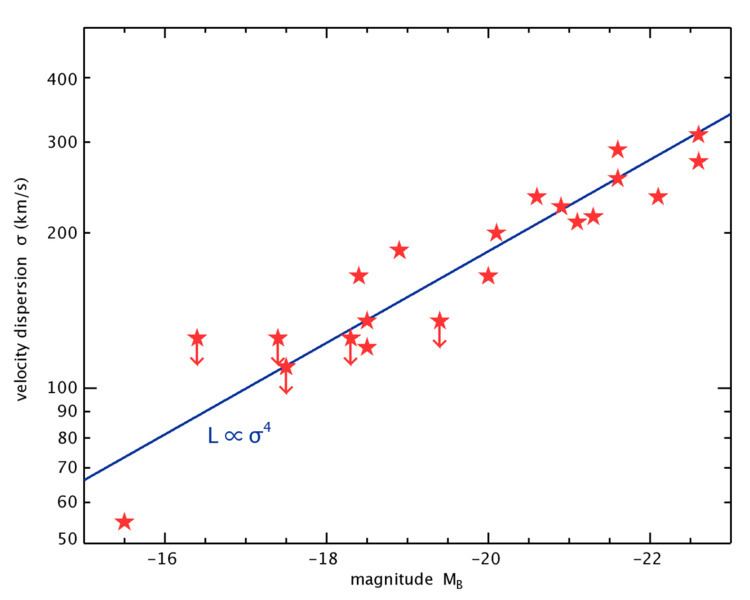 | ||
The Faber–Jackson relation is an early empirical power-law relation between the luminosity
Contents
where the index
Theory
The gravitational potential of a mass distribution of radius
Where α is a constant depending e.g. on the density profile of the system and G is the gravitational constant. For a constant density,
The kinetic energy is (recall
From the virial theorem (
If we assume that the mass to light ratio,
Let us introduce the surface brightness,
Using this and combining it with the relation between
and by rewriting the above expression, we finally obtain the relation between luminosity and velocity dispersion:
that is
When account is taken of the fact that massive galaxies originate from homologous merging, and the fainter ones from dissipation, the assumption of constant surface brightness can no longer be supported. Empirically, surface brightness exhibits a peak at about
for the less massive galaxies, and
for the more massive ones. With these revised formulae, the fundamental plane splits into two planes inclined by about 11 degrees to each other.
Even first-ranked cluster galaxies do not have constant surface brightness. A claim supporting constant surface brightness was presented by astronomer Allan R. Sandage in 1972 based on three logical arguments and his own empirical data. In 1975, Donald Gudehus showed that each of the logical arguments was incorrect and that first-ranked cluster galaxies exhibited a standard deviation of about half a magnitude.
Estimating distances to galaxies
Like the Tully–Fisher relation, the Faber–Jackson relation provides a means of estimating the distance to a galaxy, which is otherwise hard to obtain, by relating it to more easily observable properties of the galaxy. In the case of elliptical galaxies, if one can measure the central stellar velocity dispersion, which can be done relatively easily by using spectroscopy to measure the Doppler shift of light emitted by the stars, then one can obtain an estimate of the true luminosity of the galaxy via the Faber–Jackson relation. This can be compared to the apparent magnitude of the galaxy, which provides an estimate of the distance modulus and, hence, the distance to the galaxy.
By combining a galaxy's central velocity dispersion with measurements of its central surface brightness and radius parameter, it is possible to improve the estimate of the galaxy's distance even more. This standard yardstick, or "reduced galaxian radius-parameter",
